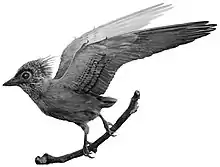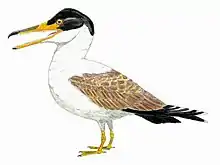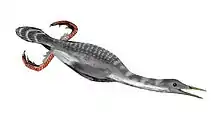Xixianykus
Xixianykus is a genus of alvarezsauroid theropod dinosaur from the late Cretaceous period of China.[1]
| Xixianykus | |
|---|---|
| Scientific classification | |
| Kingdom: | Animalia |
| Phylum: | Chordata |
| Clade: | Dinosauria |
| Clade: | Saurischia |
| Clade: | Theropoda |
| Family: | †Alvarezsauridae |
| Genus: | †Xixianykus Xu et al, 2010 |
| Species: | †X. zhangi |
| Binomial name | |
| †Xixianykus zhangi Xu et al., 2010 | |
Discovery and naming
The fossil, holotype XMDFEC V0011, was found in the Majiacun Formation in Henan Province, China. The fossil consists of a partial skeleton, without the skull. Parts of the hind legs, pelvis and spine has also been recovered. Xixiankykus is among the oldest of the derived alvarezsauroids, the parvicursorines, dated to the Santonian–Coniacian, as opposed to other parvicursorines, which are either Campanian or Maastrichtian.[2]
The type species is Xixianykus zhangi described in 2010 by Xu Xing. The genus name refers to Xixia County and to the Greek word for claw ("onyx"). The latter is a common element used in names for Alvarezsaurids. The species name is in honor of Zhang Xinglao.
Description

Xixianykus was a small animal, about 50 centimetres (20 in) long and 20 centimetres (7.9 in) high. It is one of the smallest-known dinosaurs (not counting avians). It appears to have many adaptations towards a cursorial (running) lifestyle. It was about 50 centimetres long but had 20-centimetre-long (7.9 in) legs and a short femur combined with a long tibia and metatarsus, which are good indicators of it being a fast runner.[2] It was probably covered in feathers.
References
- Xu, X., Wang, D.Y., Sullivan, C., Hone, D.W.E., Han, F.L., Yan, R.H. and Du, F.M. (2010). "A basal parvicursorine (Theropoda: Alvarezsauridae) from the Upper Cretaceous of China.". Zootaxa, 2413: 1-19.
- Hone, D. (2010). Xixianykus zhangi - A New Alvarezsaur Dave Hone's Archosaur Musings, April 23, 2011.
External links
| Wikispecies has information related to Xixianykus. |



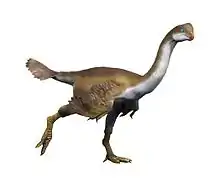
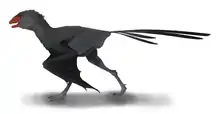
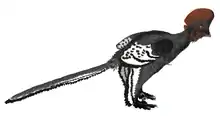
.png.webp)



.jpg.webp)
